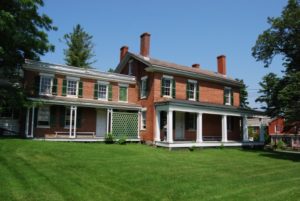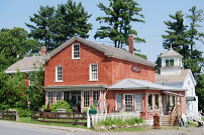Andebit et beaqui corendit, ut quostes esciendion re dit ad et prae parion es quia quas alibus sam, omnim faciden ducipidiat arum autem nobis enis es voat

3. Hammond’s Corners in the Hamlet of Crown Point
Lumber and Iron Fuel the Birth of Towns.
Listen to the Iron Story Site 3 Audio Narration:

The town park anchors the heart and history of Crown Point. Most of the buildings around and on the park were built in the 1820s and 30s. And many were the homes of the key players in Crown Point’s iron history, most notably the Hammond and Penfield families.
In 1823, the Champlain Canal opened, providing a connection to the Hudson River for the farms and businesses along Lake Champlain. Crown Point was bulging with lumbering gangs in the woods, mills along Putnam Creek, small wharves on the lakeshore, and stores popping up near population centers in the town. The abundance of the Adirondack forest at this time meant that there was a steady supply of timber for milling. The need for lumber to build the new American nation and the accessible water highway—Lake Champlain—were the catalysts for new mills and companies in Crown Point. Later, the Champlain Canal facilitated the expansion of iron mining in the Adirondacks. However, during the first half of the 19th century, the market demand for lumber was greater than that for iron.
As the land was cleared, farmers moved in to work the land. The presence of farming and mining later would develop hand-in-hand as the farming provided food for the miners and workhorses and the iron industry led to more efficient methods of farming thanks to the use of new metal tools—such as the labor-saving steel plow with interchangeable parts. The stone walls that dot the landscape are a testament to the farms that occupied many of the now-empty fields.
Hammond’s Corners was an early settlement in Crown Point. Like many other towns that sprung up near Lake Champlain, closeness to a source of water power was key. Hammond’s Corners is located on Putnam Creek, a source of water within a navigable distance of Lake Champlain.

In 1822, as the Champlain Canal was nearing completion, Col. Job Howe hired 25-year-old Charles Hammond at the rate of $1 per day to clear timber and build a dam. That dam, located where the present highway bridge (Route 22/9N) crosses Putnam’s Creek, created a millpond capable of driving several mills. Within a year, Hammond was promoted to clerk of Howe’s store. Just a year later, Howe, Hammond, and Ebenezer Harwood formed the lumber company C. F. Hammond that became Hammond & Company when Charles’s brother, John Cross Hammond, bought out Howe’s interest. Together, they took over Howe’s lumber business and store, located on the east end of the park, and spearheaded the construction of the First Congregational Church and its parsonage, on the west and north sides respectively. The Old Brick Store at Hammond’s Corners, built in 1827 and used for their lumber business, still stands on the east end of the park today. It is the oldest existing commercial building in the town and still operates as a store. Charles Hammond and his brother, John, built adjacent homes to the south of the park. Yet only his son Thomas’s home still exists.
Charles F. Hammond was exposed to the iron business through his father-in-law, John Renne, who operated the first iron forge near Crown Point Center in 1823. Hammond became a founding partner of Crown Point Iron Company in 1845 and spent 21 years at its helm until he sold his interest to his sons John and Thomas. C.F. Hammond was a “mogul” in the truest sense, owning mills and forestland well beyond Essex County—in St. Lawrence, Hamilton, and Hamilton counties.
Allen Penfield, Charles’ brother-in-law, was another partner in the Crown Point Iron Company. Charles Hammond died in 1873 at the age of 75—only three weeks after the tragic death of his son Thomas.
The surviving son, John Hammond, was born in Crown Point in 1827, received a public education in St. Albans, Vermont, and graduated from Rensselaer Institute (now Rensselaer Polytechnic Institute) which was the institution for educating future iron industrialists. At the start of the Civil War, John formed Company H, Fifth Cavalry, the funds for the cavalry horses coming from his father, and rose to the rank of Brigadier General. A trustee and president of the second Crown Point Iron Company after its reincorporation, John Hammond was also a Representative of New York’s 18th Congressional District from 1879 to 1883. After four years, he declined re-election. John Hammond died in 1889 and is interred in Crown Point’s Forest Dale Cemetery, where a monument stands to him.
Travel Tools
Park along the green on Park Avenue. Note that Lake Champlain lies just a half-mile to the east, and Putnam Creek flows under the road a few hundred yards to the north. Noteworthy highlights of Crown Point Green Historic District:
- The home of Col. Job Howe faces the northeast corner of the park, 29 Park Avenue. The residence embodies one of Crown Point’s most important entrepreneurs and residents during the 19th The home was built in 1826. Howe used stone from the fort ruins at Crown Point for the foundation of his building. He also built the Old Brick Store and the Congressional Church.
- First Congressional Church, 9 Park Avenue. Most of the early settlers of Crown Point were from Vermont and elsewhere in New England, who were largely members of the Congressional Church. Thus, one of the earliest churches in Crown Point was the Congressional Church. The land on which the church was built was given by John Howe, who also contributed substantially to its construction, which began in 1829.
- On the Green itself is the Veterans Memorial Park, a small fenced area at the center of the park. The 34-foot-tall Soldier’s Monument is a memorial to the Crown Point citizens who died during the Civil War. It was erected by Charles F. Hammond. Nearby is a granite obelisk dedicated to General John Hammond’s beloved Morgan horse, Pink, which carried him throughout his service in the Civil War.
- Home of Charles F. Hammond, 2076 Creek Road. The Hammond Chapel was originally built as a home for Charles F. Hammond in 1837 and it is among the most architecturally distinctive buildings in the town. It was later converted into a chapel.
- Home of Thomas Hammond, 2056 Creek Road. The main part of this home is probably one of the oldest buildings in the district. This evidence includes multiple citations indicating that this was the circa. 1812 “Widow Wilcox’s tavern,” which was once located near the site of the present Hammond Chapel (Charles F. Hammond House). It was then moved to its present location around 1837 when the Charles Hammond house was built. In its new location, it was likely remodeled and then eventually used as the home of Charles Hammond’s son, Thomas (1835-1873). But the evidence of the early age of this building is also in its design and construction.

CLICK TO ADVANCE PAGE TO SITE FOUR
Detour: Forest Dale Cemetery:
Site of the General John Hammond Monument and a Civil War Graveyard.


